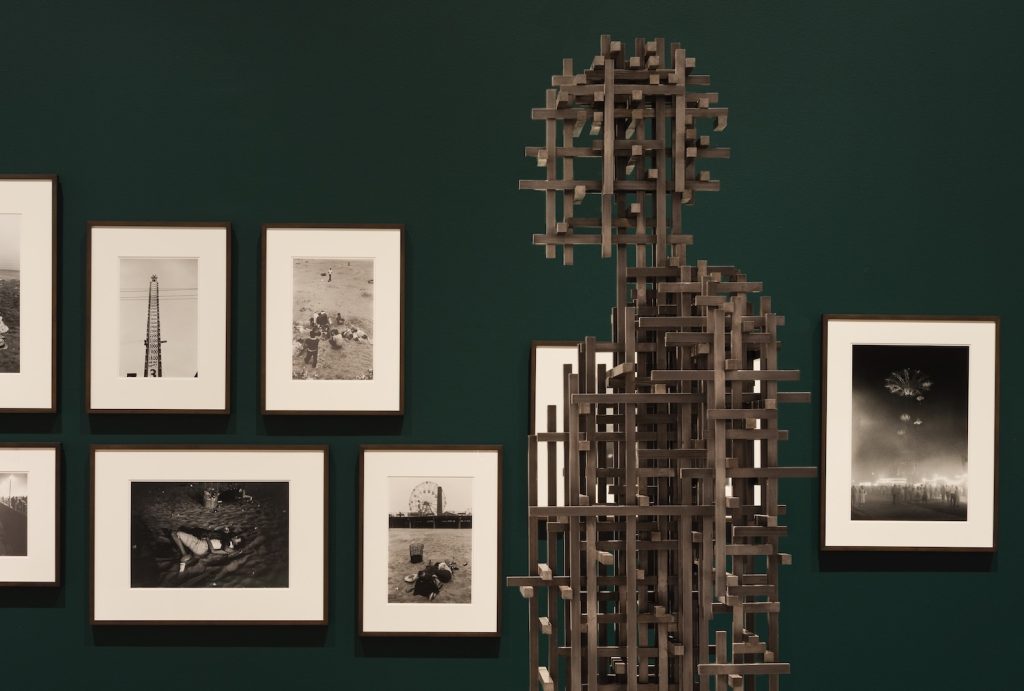A bicentennial is a rare milestone for any organization. For the Brooklyn Museum, it’s been an opportunity to commemorate its legacy, but also affirm its commitment to being the borough’s most diverse and dynamic source of arts and culture programming.
In BKMAG‘s continued coverage of the Brooklyn Museum’s 200th anniversary, we’re excited to turn the spotlight over to Breaking The Mold, a must-see exhibition showcasing the museum’s most prominent works, from recent additions to its collection to its most seasoned and celebrated holdings.
Breaking The Mold treats visitors to over 220 objects on view, which have been expertly selected from more than 140,000 pieces spanning 6,000 years of history in the museum’s collection. The exhibit is organized into three inspiring chapters to help tell the story of the museum’s rich history: “Brooklyn Made,” “Building the Brooklyn Museum and Its Collection,” and “Gifts of Art in Honor of the 200th.”
Georgia O’Keeffe. Brooklyn Bridge, 1949. Oil on masonite (Courtesy of Brooklyn Museum)
“I think Georgia O’Keeffe’s painting of the Brooklyn Bridge is one of our collection’s biggest highlights, and I’m so excited to have it in the show. My favorite piece, however, is the carousel horse from Coney Island. I think its presence in the gallery is unexpected, greeting you when you enter the exhibition,” shares Liz St. George, Assistant Curator of Decorative Arts, who worked on “Brooklyn Made.”
As the name suggests, this chapter showcases art and design created in Brooklyn from the 17th century to today. Locals will be delighted to see the work of artists who have operated or based themselves in Kings County, as well as art about the borough itself. “I started by thinking about Brooklyn icons like the Brooklyn Bridge, Coney Island, and Prospect Park, and how they could relate to one another, but also be framed and discussed in new lights. From there, I pulled together a few themes, like labor and industry, land settlement, and community building. In addition to Brooklyn icons, I wanted to highlight lesser-known collection works that maybe had not yet been on view,” St. George explained of her approach to curating the “Brooklyn Made” section.
Catherine Green. Untitled, 1991. Chromogenic print (Courtesy of Brooklyn Museum)
The second chapter, titled “Building the Brooklyn Museum and Its Collection,” introduces visitors to artworks and archival materials that trace the development of the building’s architecture and the museum’s robust collection. “We worked with our colleagues [in] curatorial, architecture and building, and archives to solicit material that would engage our audiences and tell really compelling stories. We prioritized Brooklyn icons that are not on view in collection galleries and those collections that do not have dedicated collection galleries,” said Catherine Futter, Director of Curatorial Affairs and Senior Curator of Decorative Arts.
Here, patrons can explore the museum’s rich history through a range of notable facts and sights. When asked about which facts particularly stuck with her, Futter pointed out how most museum collections are sourced from the generosity of collectors. However, Brooklyn Museum’s approach to building a collection has been unique. Its methods have included commissioning artworks in the 1840s and 1850s, sponsoring archaeological excavations, and crowd-sourcing funds to acquire works.
“Many people do not know that our museum was originally founded as the Brooklyn Apprentices’ Library, which was the first public circulating library in Brooklyn. General Lafayette laid the first library building’s cornerstone, which is on view in the exhibition, and Walt Whitman was present at the ceremony as a child,” recalled Abigail Dansiger, Director of Libraries & Archives.
For Meghan Bill, Coordinator of Provenance, this section is about emphasizing how the museum’s long-standing core values were decades ahead of conversations we’re only just beginning to have about institutional diversity and inclusion. “Overall, I was struck by how many things we might think of as contemporary—commitment to sharing the work of BIPOC and women artists, ensuring free or low-cost access to art education, engaging with our local Brooklyn community—have always been Brooklyn Museum priorities,” she said.
Coco Fusco, video installation (Courtesy of Brooklyn Museum)
The last chapter in Breaking the Mold spotlights the contemporary works given by valued donors in honor of the museum’s bicentennial. According to Pauline Vermare, Phillip and Edith Leonian Curator of Photography, the can’t-miss pieces on view in this section include Joel Sternfeld’s “One is Our Loss” and Coco Fusco’s video installation.
“Being the photography curator, I wanted the many beautiful photographs—by Robert Frank, Joel Sternfeld, Irving Penn, the Bechers, Tina Barney—to shine. And I wanted all these gifts, these extraordinary works, to echo each other like a choir,” Vermare told us. “The first room is centered around a ‘human presence.’ And the second room, which is more abstract, is anchored around the theme of ‘shaping the future.’ I wanted to convey a sense of awe, energy, and gratitude to convey the meaning of philanthropy itself: The love of humankind.”
One of the exhibition’s highlights is its ability to celebrate Brooklyn artists and art without defining them too rigidly. “It’s hard to pin down what makes a Brooklyn artist. However, I will say that Brooklyn artists are observant, tackling some of the core issues of our day, such as representation and migration,” St. George opined. “I also think they are adventurous, and sometimes scrappy, playing with new ideas of form and material in challenging economic and social circumstances, but with the highest level of skill and thoroughness of concept.”
Breaking the Mold: Brooklyn Museum at 200 is on view at Brooklyn Museum through February 22, 2026. Click here to plan your visit.
The post Breaking The Mold: Brooklyn Museum Plays The Hits and Toasts The Borough appeared first on BKMAG.

